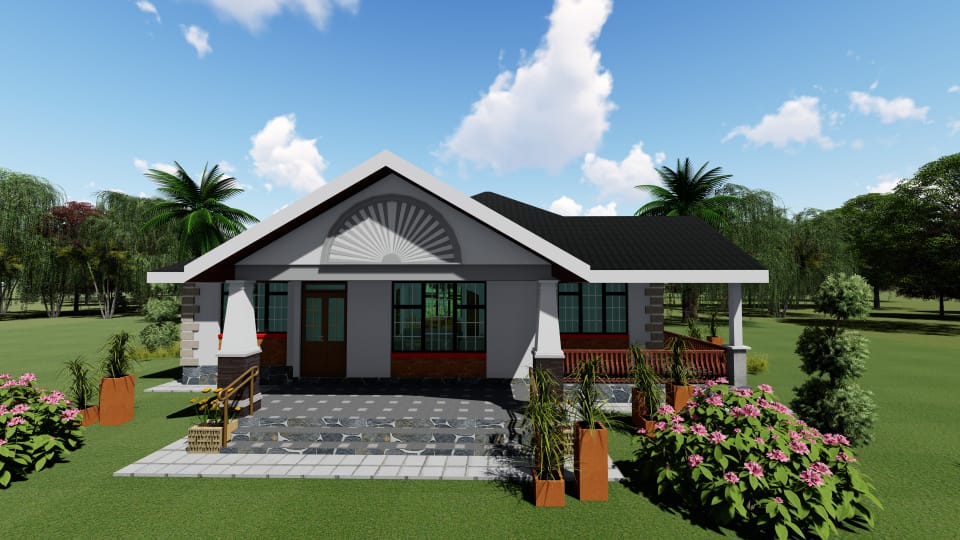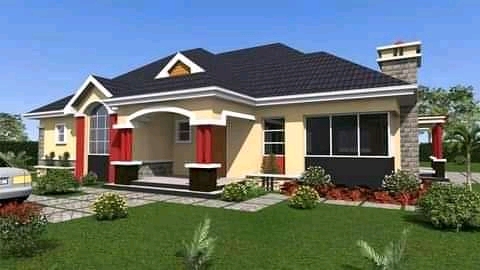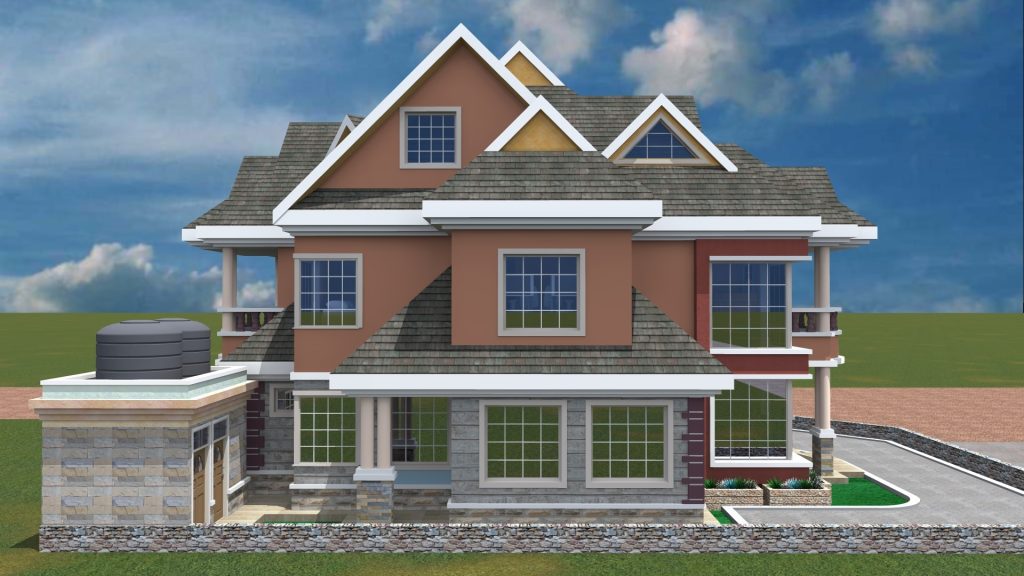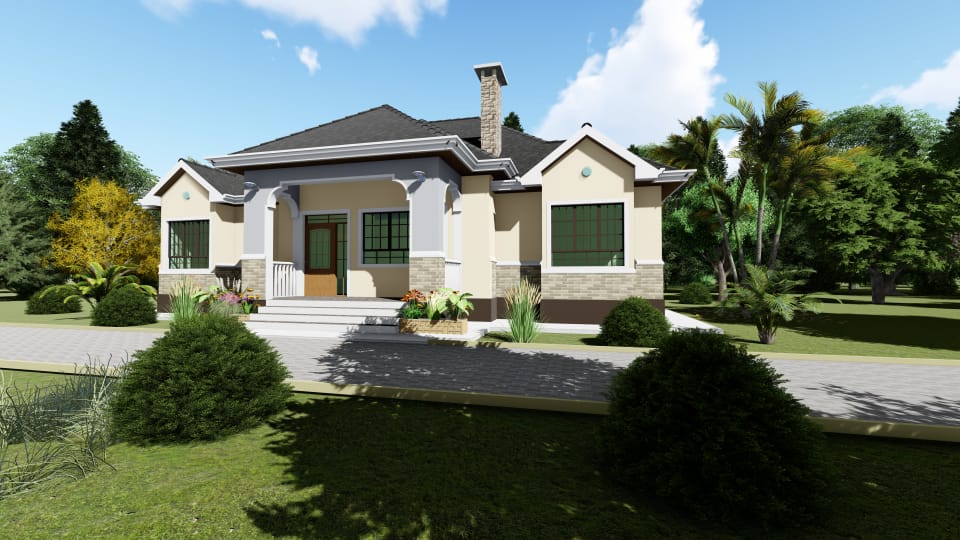I. Introduction
The housing market in Kenya has been a topic of significant interest and discussion in recent years. As the country experiences rapid urbanization and population growth, the demand for housing, particularly for larger families, has surged. Among the various aspects associated with housing, the cost of construction stands out as a critical factor that greatly influences the accessibility of housing options for Kenyan citizens. This article aims to shed light on the average cost of building a 4-bedroom house in Kenya, delving into the factors that contribute to this cost variation and the broader implications for the housing market.
A. Brief Overview of the Housing Market in Kenya
Kenya, a country known for its diverse landscapes and vibrant culture, is also facing the challenges of providing adequate and affordable housing for its citizens. The urban centers, especially Nairobi and Mombasa, have seen rapid expansion as people from rural areas migrate in search of better economic opportunities. This urban influx has led to an increased demand for housing, which has, in turn, impacted housing costs and construction activities.


Related post: 4 Excellent House Designs in Kenya and Cost of Building
B. Importance of Understanding the Average Cost of Building a 4-Bedroom House
The construction of a house, particularly one with four bedrooms, represents a substantial investment for any individual or family. It’s an endeavor that involves not only financial commitments but also emotional ones. Understanding the average cost of building a 4-bedroom house is of paramount importance for several reasons:
- Informed Decision Making: Prospective homeowners need accurate information to make informed decisions about their housing projects. Knowing the average cost helps them set realistic budgets and evaluate the feasibility of their plans.
- Budget Planning: Construction projects are notorious for their potential to exceed initial budgets. Knowing the average cost serves as a guideline to create a budget that covers various aspects of construction, from materials to labor and unexpected contingencies.
- Comparative Analysis: With the housing market experiencing regional variations, understanding the average cost enables individuals to compare costs across different locations and make strategic choices about where to build.
- Financial Accessibility: Government initiatives and financial institutions often offer housing loans and mortgages. Knowledge of the average cost allows individuals to gauge their financial eligibility and negotiate better loan terms.
C. Purpose and Scope of the Article
This article aims to provide valuable insights into the average cost of building a 4-bedroom house in Kenya. It will explore the factors that contribute to the cost variations, such as location, design, materials, labor, and infrastructure. By presenting case studies from different regions and settings, readers will gain a comprehensive understanding of how these factors interact and influence the overall construction cost. Additionally, the article will offer tips for cost control, strategies for efficient budgeting, and considerations for navigating the evolving housing market.
Related post: Maisonette House Plan Kenya-4BR Flat Roof
In the subsequent sections, we will delve deeper into the intricacies of construction costs, analyze regional variations, present real-world case studies, and discuss future trends that could shape the cost landscape of building 4-bedroom houses in Kenya. By the end, readers will have a solid foundation to approach their own housing projects with confidence and clarity.

II. Factors Influencing the Cost of Building
Building a 4-bedroom house is a multifaceted endeavor, and the cost of construction is influenced by a multitude of factors. Understanding these factors is crucial for anyone embarking on a housing project in Kenya. Let’s delve into the key elements that contribute to the variations in building costs:
Related post: Why the Design and Build Concept is Ideal for Private Developers
A. Location and Land Costs
- Urban vs. Rural Areas: Location plays a pivotal role in determining construction costs. Urban areas like Nairobi tend to have higher costs due to factors such as higher land prices, increased demand for labor, and stricter building regulations. In contrast, rural areas generally offer more affordable construction options.
- Land Prices and Availability: The cost of land varies significantly across different regions. Urban centers command higher land prices, driving up the overall cost of the project. Availability of suitable land also affects costs, as limited availability may lead to higher competition and elevated prices.
B. House Design and Size
- Architectural Complexity: The intricacy of the house design directly impacts the construction cost. Unique architectural features, unconventional layouts, and custom designs often require specialized labor and materials, thereby increasing costs.
- Square Footage: The size of the house, measured in square footage, is a major determinant of construction expenses. Larger houses require more materials, labor, and time, contributing to higher costs. However, cost per square foot tends to decrease as the size of the house increases.
Related post:Secrets Revealed! How Much Does it Cost To Build a 4 Bedroom House in Kenya
C. Material Selection
- Quality of Construction Materials: The choice of construction materials significantly affects the final cost. Opting for higher-quality materials often leads to greater durability and longevity, but it also comes at a higher price. Balancing quality with budget constraints is a crucial decision.
- Local Availability and Imports: The availability of construction materials in the local market influences costs. Imported materials incur additional expenses due to transportation, taxes, and customs duties. Using locally sourced materials can be cost-effective and supports local industries.
D. Labor Costs
- Skilled vs. Unskilled Labor: Skilled labor, such as experienced masons and carpenters, commands higher wages compared to unskilled labor. Complex tasks requiring specialized skills contribute to increased labor costs.
- Wage Rates in Different Regions: Labor costs vary across regions based on factors like living expenses and demand for skilled workers. Urban areas generally have higher wage rates compared to rural areas.
E. Infrastructure and Utilities
- Access to Water, Electricity, and Sewage: The availability and accessibility of basic infrastructure services impact construction costs. Connecting a house to water, electricity, and sewage systems adds to the overall expenses.
- Impact on Overall Construction Expenses: Adequate infrastructure and utilities enhance the livability of a house but also increase construction expenses. Costs associated with installing systems like plumbing and electrical wiring can significantly contribute to the budget.
Understanding these factors and their interplay is essential for accurately estimating the cost of building a 4-bedroom house in Kenya. Each factor influences the others, creating a dynamic landscape where decisions made in one area may have cascading effects on overall costs. By considering these factors during the planning phase, individuals can develop a realistic budget and make informed choices that align with their goals and financial capabilities.

III. Average Cost Breakdown
Building a 4-bedroom house involves a range of construction activities and components that collectively contribute to the overall cost. Understanding the breakdown of these costs is essential for homeowners and builders alike. Let’s explore the average cost breakdown of building a 4-bedroom house in Kenya:
Related post: 3-BEDROOM PREFAB HOUSE COST IN KENYA
A. Site Preparation and Foundation
- Clearing, Excavation, and Leveling: This initial phase involves preparing the construction site by clearing vegetation, excavating the ground, and leveling it for construction. Costs can vary based on the size of the plot and the nature of the terrain.
- Foundation Type: The choice of foundation type impacts both cost and structural integrity. Options include a concrete slab, crawl space, or basement. Each type has its own cost implications based on excavation depth and materials required.
Related post: Exceptional 4 Types of House Plans in Kenya
B. Structural Construction
- Walls, Roofing, and Flooring: This phase involves constructing the main structural elements of the house, including walls, roofing, and flooring. Costs vary based on the materials chosen (brick, concrete, timber, etc.) and the complexity of the design.
- Framing Materials and Techniques: The framing of walls and roof structures requires materials like timber or steel. The framing technique chosen (wooden frame, steel frame, etc.) impacts costs and construction time.
C. Interior Finishes
- Flooring, Painting, and Ceiling Finishes: Interior finishes encompass flooring materials (tiles, hardwood, laminate, etc.), painting, and ceiling treatments. Costs vary based on the quality of finishes selected.
- Cabinetry, Fixtures, and Fittings: Installing cabinetry in the kitchen and bathrooms, along with fixtures like sinks, faucets, and lighting, contributes to interior costs. The choice of materials and design influence these expenses.
D. Utilities Installation
- Electrical and Plumbing Systems: Installing electrical wiring, outlets, switches, and plumbing systems (pipes, drainage, water supply) is a crucial phase. Costs depend on the complexity of the systems and the number of rooms and bathrooms.
- HVAC (Heating, Ventilation, and Air Conditioning): If HVAC systems are included, the cost varies based on the type of system chosen, the number of zones, and the house’s size.
E. Landscaping and Exterior
- Outdoor Spaces, Garden, and Driveway: Creating outdoor living spaces, gardens, and driveways enhances the overall appeal of the property. Costs depend on landscaping features, materials, and size.
- Fencing and Security Features: Installing fences, gates, and security features like cameras and alarms adds to the cost. The level of security desired influences these expenses.
Related post: MOST BEAUTIFUL AND CHEAPEST HOUSE DESIGN IN KENYA
Understanding this cost breakdown empowers homeowners to make informed decisions throughout the construction process. It’s important to note that these breakdowns are general estimates, and costs can vary based on factors such as location, market conditions, and individual preferences. By meticulously planning each phase and considering cost-saving measures where possible, individuals can manage their budget effectively and ensure that the construction process stays on track.
IV. Regional Variations in the Cost of Building a 4-Bedroom House
The cost of building a 4-bedroom house in Kenya varies significantly across different regions due to factors such as local materials, labor availability, economic conditions, and geographical influences. Here’s an overview of how costs differ in various regions:
A. Nairobi Metropolitan Area
The capital city, Nairobi, and its metropolitan region experience some of the highest construction costs in the country. The demand for housing, coupled with limited land availability, drives up land prices and overall construction expenses. Skilled labor is abundant but more costly. Additionally, the cost of living and access to premium materials contribute to higher costs for both construction and finishes.
B. Coastal Regions
Coastal areas like Mombasa and Malindi have unique construction considerations due to their proximity to the ocean. Building materials must withstand the corrosive effects of saltwater and humid conditions. While labor costs might be lower compared to Nairobi, the cost of coastal-friendly materials and engineering requirements can balance out the expenses.
C. Rift Valley and Central Regions
Regions such as Nakuru and Nyeri experience moderate construction costs. Land is relatively available and affordable, and labor costs are reasonable. However, altitude and climate variations might necessitate adjustments in construction methods and materials, which can influence costs.
D. Eastern and Western Kenya
Eastern and Western regions, including towns like Embu and Kisumu, generally offer more affordable construction options. Land prices are moderate, and labor costs are relatively lower. Materials such as timber might be more accessible and economical in these areas, potentially leading to cost savings.
E. Northern and Arid Areas
Regions like Turkana and Wajir present unique challenges due to arid conditions and limited access to resources. Building materials might need to be transported from afar, increasing costs. Additionally, extreme temperatures demand specific construction techniques and materials, which can affect expenses.
Related post: Best 10 House Plans in Kenya and Africa
Regional variations in costs are crucial considerations when planning a construction project. Individuals must assess the specific conditions of the chosen location and factor in local material availability, labor market dynamics, and any climate-related implications. By understanding these regional nuances, homeowners can more accurately budget for their 4-bedroom house project and make informed decisions based on local conditions.
Related post: 4 BEDROOM HOUSE PLANS IN KENYA PDF
V. Case Studies: Exploring Building Costs in Different Settings
A. Example 1: Building Costs in Nairobi
- Detailed Breakdown of Costs: In the bustling Nairobi metropolitan area, building a 4-bedroom house is a substantial investment. The cost breakdown includes high land prices, materials tailored for urban conditions, and skilled labor. Expenses cover site preparation, foundation, structural construction, interior finishes, utilities installation, landscaping, and exterior features.
- Factors Affecting Cost Variations: The cost variations in Nairobi are influenced by the intense demand for housing, limited land availability, premium materials required for urban living, and competitive labor market. Stricter building codes, higher land prices, and increased access to modern amenities contribute to the elevated costs.
B. Example 2: Building Costs in a Rural Setting
- Comparison with Urban Costs: Building a 4-bedroom house in a rural area offers cost advantages compared to urban settings. The cost breakdown includes more reasonable land prices, potentially lower labor costs, and materials sourced from the local environment.
- Impact of Local Materials and Labor: Utilizing locally available materials like bricks, timber, and stone can significantly reduce expenses. Labor costs may be more affordable due to lower living costs in rural areas. However, certain construction challenges might arise, such as limited access to specialized labor or modern infrastructure.
C. Example 3: Upscale vs. Affordable Housing
- Cost Differences between Luxury and Basic Finishes: Building a 4-bedroom house with luxury finishes, such as high-end flooring, premium fixtures, and customized cabinetry, comes at a significantly higher cost compared to a house with basic finishes. Luxury finishes demand top-tier materials and skilled craftsmanship, while basic finishes prioritize cost-effectiveness.
- Catering to Different Market Segments: Addressing diverse market segments involves understanding cost variations. Upscale housing targets those seeking luxury living, while affordable housing focuses on practicality and budget constraints. Developers must balance the quality of finishes with market demands to ensure the project’s success.
Case studies provide invaluable insights into the real-world costs and considerations of building a 4-bedroom house in different contexts. By examining these examples, individuals can gain a clearer understanding of the factors that influence costs, make informed decisions about materials and finishes, and tailor their projects to meet the specific needs of their chosen market segment and location.
VI. Tips for Cost Control in Building a 4-Bedroom House
Managing costs during the construction of a 4-bedroom house requires careful planning and strategic decision-making. Here are key tips to help control costs effectively:
A. Budgeting and Planning
- Thorough Cost Estimation: Begin with a comprehensive cost estimation that includes all phases of construction. Account for contingencies to handle unexpected expenses.
- Realistic Budget Setting: Set a realistic budget that considers your financial capabilities and market conditions. Allocate funds for each construction phase and allocate a portion for unexpected costs.
Related post: 10 Common Questions about the Cost of building a 3 bedroom house in Kenya
B. Material Sourcing and Alternatives
- Local Materials: Opt for locally sourced materials whenever possible. They are usually more cost-effective due to reduced transportation expenses.
- Alternatives: Explore alternative materials that provide similar functionality at a lower cost. For example, consider engineered wood instead of solid wood for structural elements.
C. Efficient Design and Layout
- Space Optimization: Efficient design and layout can reduce the overall square footage, which in turn lowers construction costs.
- Minimize Complex Features: Intricate architectural features can drive up costs. Balance aesthetics with affordability to maintain a reasonable budget.
D. Contractor Selection and Negotiation
- Multiple Bids: Obtain quotes from multiple contractors to ensure competitive pricing. Evaluate their experience and reputation before making a decision.
- Negotiation: Negotiate prices with contractors and suppliers. Many are open to discussions, especially when they understand your budget constraints.
E. Regular Monitoring and Quality Assurance
- Project Monitoring: Regularly monitor the construction progress and expenses. Address any deviations from the budget promptly.
- Quality Control: Prioritize quality to avoid costly rework in the future. Quality construction reduces maintenance expenses and enhances property value.
By implementing these cost-control strategies, homeowners can navigate the construction process with greater financial confidence. While aiming for cost savings, it’s important to strike a balance between cutting expenses and ensuring the durability, safety, and functionality of the completed house. A well-executed cost management plan can lead to a successful construction project that aligns with your budget and expectations.
VII. Future Trends in House Construction Costs
The construction industry is continually evolving, influenced by various factors that impact costs and practices. Understanding future trends in house construction costs is crucial for effective planning and decision-making. Here’s a look at some anticipated trends:
A. Projected Changes in Material Costs
- Fluctuating Material Prices: The prices of construction materials can be volatile due to factors like supply chain disruptions, global demand, and geopolitical events. Keeping an eye on these trends can help homeowners anticipate potential cost fluctuations.
- Sustainable Materials: As environmental concerns grow, there’s a shift towards sustainable building materials. While some eco-friendly options may initially have higher upfront costs, their long-term benefits and market demand could impact construction costs over time.
B. Technological Advancements and Their Impact
- Prefabrication and Modular Construction: Prefabrication and modular construction methods are gaining traction. These approaches offer efficiency in construction, reduced waste, and potentially lower labor costs due to streamlined processes.
- Building Information Modeling (BIM): BIM technology enhances collaboration among construction teams and minimizes errors during design and construction phases. While adopting BIM might have initial implementation costs, it can lead to overall cost savings and improved project efficiency.
- Automation and Robotics: Automation and robotics are gradually entering construction sites, reducing labor requirements and increasing precision. While there are upfront investments in technology, long-term savings might result from reduced labor costs and increased productivity.
C. Government Policies and Regulations
- Green Building Codes: Governments worldwide are increasingly implementing green building codes that mandate energy-efficient and sustainable construction practices. Compliance might lead to additional costs initially, but the long-term benefits include reduced utility expenses and enhanced market value.
- Incentives and Subsidies: Governments often provide incentives and subsidies for eco-friendly construction practices or affordable housing projects. These initiatives can offset certain construction costs and encourage the adoption of specific building methods.
- Regulations Impacting Land Costs: Zoning regulations and land use policies influence land availability and costs. Changes in these regulations can impact the cost of acquiring land for construction.
As these trends continue to shape the construction industry, individuals planning to build a 4-bedroom house should stay informed about these developments. While some trends might introduce new costs, others could lead to long-term savings and enhanced property value. Adapting to these changes and incorporating them into your construction strategy can ensure a more efficient, cost-effective, and sustainable building process.
VIII. Conclusion: Navigating the Cost Landscape of Building a 4-Bedroom House in Kenya
As you embark on the journey of building a 4-bedroom house in Kenya, you’ll encounter a dynamic landscape of costs influenced by numerous factors. Throughout this article, we’ve delved into the critical aspects that shape the expenses associated with construction. Let’s recap the key points and highlight the essential takeaways:
Related post: Where to find cheap house designs in Kenya
A. Recap of Key Points
- Factors Affecting Costs: The location, house design, materials, labor, infrastructure, and finishes all contribute to the overall cost of building a 4-bedroom house.
- Regional Variations: Construction costs vary across different regions of Kenya due to factors such as urban vs. rural settings, material availability, labor rates, and geographic influences.
- Average Cost Breakdown: The construction process can be divided into site preparation, structural construction, interior finishes, utilities installation, and landscaping, each with its own set of associated costs.
- Case Studies: Exploring case studies from Nairobi, rural areas, and comparing upscale vs. affordable housing highlights how context influences costs and decision-making.
- Cost Control Strategies: Effective budgeting, material selection, efficient design, careful contractor selection, and quality assurance are vital strategies for managing and controlling construction costs.
- Future Trends: Anticipating changes in material costs, technological advancements, and governmental policies can guide your decisions and ensure long-term cost-effectiveness.
B. Emphasis on the Importance of Thorough Research and Planning
Thorough research and planning are the cornerstones of a successful construction project. By understanding the unique factors influencing construction costs in your chosen location and considering future trends, you can make informed decisions that align with your budget and vision.
C. Encouragement to Consult Professionals for Accurate Cost Estimates
Building a 4-bedroom house is a significant undertaking that involves complex decisions. To ensure accurate cost estimates and expert guidance, consult professionals such as architects, contractors, and construction experts. Their experience and insights will help you navigate the intricacies of the construction process, avoid costly mistakes, and achieve your housing goals.
In your pursuit of creating a comfortable and welcoming home, remember that knowledge, careful planning, and strategic decision-making are your most valuable tools. As you apply the insights gained from this article, you’ll be better equipped to navigate the challenges and rewards of building a 4-bedroom house in Kenya.






3 thoughts on “Understanding the Average Cost of Building a 4-Bedroom House in Kenya”